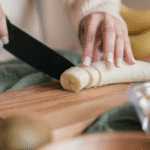Rice is a staple food; if you have diabetes, how can you stop eating your favorite grain? Only by limiting the number of additives, carbohydrates, and sugar levels can you eat rice.
Some people prefer brown rice over white rice, and they believe that white rice is refined and will raise their sugar levels; However, brown rice has more fiber, nutrients, and minerals as compared to white rice, whose husk and dust got removed, still you can consume white rice if you balance your rice intake with low- fruits, vegetables.
Does a question arise about how you can balance your diet?
The answer is to use my plate method.
My Plate Method
This method is used as a guiding tool for overweight, diabetic patients. You should fill up to 20 percent of your plate with starchy grains, 25 percent with protein, and 50 percent with fruits and vegetables. Half of my plate for diabetic patients contains fruits and vegetables.
According to MyPlate, you should include fruit and vegetables on half of your plate.
Next, fill just less than a quarter of your plate with protein. It does not matter if it is plant-based or animal-based.
A glass of milk is also added to it. If you don’t keep an eye on your diet, there are high chances of kidney diseases, CVD, and foot infections.
Good Types of Rice
- Basmati rice
- Brown rice
- Wild rice
These are the diabetic-friendly types of rice that you should try. They are packed with nutritional content and contain sufficient fiber and minerals.
The GI value of brown rice is as low as 60, making it a healthy portion. Brown rice is rich in dietary fiber, which stops the absorption of the nutrient zinc. Due to zinc, insulin absorption occurs. Early zinc intake can destabilize insulin levels and start raising blood sugar.
The Bad Type of Rice
Short-grain white rice has low nutritional content and minimal minerals than other starches.GI score of white grain is also higher, which is greater than 70, so as a dietician, I suggest you avoid it.
White rice and brown have GI scores between 56 to 69, so you should consume them in moderation.
How to Cook Starch-Free Rice
It would be great if people started to consume scratch-free rice, and the rise in glucose levels will be low.
Wash thoroughly half cup of rice, and remove all dirt from it. Boil about two cups of water in a pan. Then add washed rice to the bowl. Cook for at least 15 minutes; once the thick white texture starts appearing, the rice will be ready in five minutes. This white matter is starch. With the help of a spoon, remove this starch. Once the water is dried, the rice is ready to eat.
Serve white rice with lentils and animal oil which does not cause a spike in glucose levels.
The Nutritional Content in Half Cup of Rice
White Rice Half Cup contains
27g total carbs
27g net carbs
2g protein
0g fat
120 calories
Why do dieticians suggest starch-free rice?
What does the Research say?
In the past, many researchers conducted additional Research on Japanese patients who ate glutinous brown rice twice a day for eight or eight weeks. Some patients left the procedure because they could not eat GRB for eight weeks. After 30 minutes, post-prandial glucose levels also fee, but there was no change in glycemic control. So patients tolerated eating GRB.
Asian countries consume 3 or 4 servings per week, and the chance of rising sugar levels is higher than in western countries.
Another research confirmed that people consuming four servings of rice or an additional bowl of rice daily chance of rising blood sugar levels was 1.5 times higher than people consuming two servings per week. So go for a smaller portion of rice containing low carbohydrates.
Diabetic-Friendly Rice Recipes:
Low-Carb Cauliflower Rice
- ¼ cup cilantro
- ½ cup lime juice
- Ten 0z cauliflower frozen rice
- Three pinches salt
- 2 tsp olive oil
How to Cook Low-Carb Cauliflower Rice?
Heat the pan, and sprinkle olive oil. Add cauliflower frozen rice and cook for 10 minutes by adding 1 cup of water.
Add lime juice and chopped cilantro, and give a nice mix. You are ready to eat. This recipe can be a good option for diabetic patients.
FAQs
Are rice cakes a good choice for diabetic patients?
Some rice cakes are not a good choice at all. Rice is a high glycemic index grain, even when it’s a whole grain (brown), so it can spike blood sugar levels. Moreover, some brands add sugar or corn syrup to their rice cakes. To try rice cakes as a snack, top them with peanut butter, cream cheese, or another spread containing fat and protein, and test your blood glucose two hours later. You can have rice cakes without a problem.
Can diabetic patients eat rice Idli?
As a dietician, I suggest patients fill half their plate with vegetables and a quarter with protein. For vegetarians, it can be lentils; for others, the protein portion consists of poultry and fish. The last quarter of the plate should consist of a small portion of rice.
Can people with diabetes eat rice pudding?
Rice pudding is not a healthy choice, but you can still eat it if you keep an eye on your eating pattern for the rest of your day; exceptionally nutritious food. Rice pudding fulfills almost 8% of phosphorus needs.
It’s also important to educate yourself about proper diet, lifestyle, and exercise routine options to maintain an excellent quality of life. If you eat more significant portions, there is 100% chance of a rise in sugar levels. Just keep reminding yourself to balance, balance, and balance.
Related Articles:
